#canis-equus
Explore tagged Tumblr posts
Text
#Fashionborne? #Fashionborne.


(Nacht just has the Top Hat instead of Eileen's hood here)
My truth is that these are Bloodborne references in Black Clover.


Nacht in this killer outfit and the hunter's set. Tho i think its more appropriate to have to compare it to Djura's set but dyed in black.


Demon soul pill and beast blood pellet.
Now i know herbal pills and the like are common in east asian cultures, its just cool to see it there ok.
Thats the post. Thank you.
#black clover#black clover spoilers#bloodborne#you could argue it's just generic plague doctor but i find that hard to believe considering how similar canis is to the default hunter set#also i don't have much to say about felis's design bc i don't know enough abt the other fromsoft games but it does fit the theme of—#“oddly out of place far east object in my very european inspired game” (hello chikage)#debating on whether or not i want to take the opportunity to go off on equus's design or not#there's a lot I want to say but I lack the vocab or the coherency for it and it might be better off as a separate post anyhow
27 notes
·
View notes
Note
oh your a fire emblem fan? Name every fire emblem character
bet.
Fire Emblem: Shadow Dragon and the Blade of Light (+ remake and sequel)
playable: marth, caeda, jagen, cain, abel, draug, gordin, wrys, ogma, barst, bord, cord, castor, darros, julian, lena, navarre, merric, matthis, hardin, wolf, sedgar, roshea, vyland, wendell, rickard, bantu, caesar, radd, roger, jeorge, maria, minerva, linde, jake, midia, dolph, macellan, tomas, boah, beck, astram, palla, catria, est, arran, samson, xane, tiki, lorenz (FE1), elice, gotoh, frey, norne, athena, horace, etzel, ymir, nagi
non-playable: mostyn, malledus, anna (and every following iteration that isnt playable), nyna, aurelys, anri, cornelius, liza, miloah, naga (let's slash out future iterations too), adrah, artemis, cartas, marion, iote, ordwin, ludwik, jiol, camus, michalis, gharnef, medeus, gazzak, gomer, hyman, bentheon, merach, emereus, harmein, kannival, mannu, zharov, khozen, volzhin, heimler, grigas, hollstadt, morzas, sternlin, orridyon, xemcel (me when i'm an incel with pronouns), rumel, rucke, gail, toras, dahl, yodel, eibel, willow, nehring
Fire Emblem Gaiden + Echoes
playable: alm, lukas, gray, tobin, kliff, silque, clair, clive, forsyth, python, luthier, mathilda, delthea, tatiana, zeke, mycen, celica, mae, boey, genny, saber, valbar, kamui, leon, atlas, jesse, sonya, deen, nomah, faye, fernand, emma, shade, yuzu, randal
non-playable: mila, duma, rudolf, massena, jedah, marla, hestia, dolth, jamil, desaix, slayde, barth, garth, lawson, gazelle, zakson, blake, wolff, grieth, mikhail, garcia, tatarrah, nuibaba, seazas, xaizor, magnus, mueller, jerome, gharn, hades, argentum, aurum, cerberus, naberius, liprica, halcyon, lima IV, irma, berkut, rinea, forneus, jarth
Fire Emblem: Genealogy of the Holy War
playable: sigurd, alec, naoise, arden, azelle, lex, quan, ethlyn, finn, midir, edain, dew, ayra, jamke, deirdre, chulainn, lachesis, beowolf, lewyn, silvia, erinys, tailtiu, claud, brigid, seliph, lana/muirne, larcei/creidne, scáthach/dalvin, oifey, diarmuid/tristan, lester/deimne, julia, fee/hermina, arthur/amid, iuchar, iucharba, shannan, patty/daisy, leif, nanna/jeanne, finn, ares, lene/laylea, tine/linda, febail/asaello, ced/hawk, hannibal, coirpre/charlot, altena
non-playable: oifey, arvis, shannan, mariccle, mananan, eldigan, grahnye, manfroy, sandima, kurth, victor, cigyun, lahna, dimaggio, gerrard, filat, munnir, cimbaeth, batu, imuka, eve, alva, eva, elliot, philip, boldor, macbeth, voltz, clement, zyne, chagall, jacobi, papilio, pizarl, dobarl, myos, daccar, annand, cuvuli, pamela, díthorba, donovan, lamia, slayder, vaja, byron, ring, andrey, lombard, reptor, travant, magorn, azmur, aida, lewyn/forseti, julius, manfroy, arvis, bloom, hilda, ishtar, ishtore, harold, schmidt, danann, liza, vampa, fetra, eliu, bramsel, jabarro, muhammad, ovo, brian, scipio, kutuzov, coruta, maikov, kanatz, disler, travant, arion, jake, musar, judah, ridale, morigan, zagam, robert, boyce, rodan, felipe, palmark, yupheel, fisher, daggon, baran, meng, maybell, bleg, mus, bovis, tigris, lepus, draco, anguilla, equus, ovis, simia, gallus, canis, porcus, loptous, forseti, salamander, gair, maera, heim, baldr, hoðr, od, njörun, dáinn, nál, ullr, fjalar, thrud, ced, bragi, yudu
Fire Emblem: Thracia 776
playable: leif, finn, eyvel, osian, halvan, dagdar, tanya, marty, ronan, lifis, safy, brighton, machyua, lara, fergus, karin, dalsin, asbel, nanna, hicks, shiva, carrion, selfina, cain, alva, robert, fred, olwen, mareeta, salem, perne, troude, tina, glade, deen, eda, homer, linoan, ralf, ilios, sleuf, sara, miranda, shannam, misha, xavier, amalda, conomor, diarmuid, saias, ced, galzus
non-playable: august, dryas, raydrik, veld, manfroy, julius, ishtar, reinhardt, kempf, bloom, seliph, julia, lewyn, travant, arion, altena, hannibal, coirpre, weissman, bucks, lobos, bandol, truman, aizenau, rumei, merlock, dobalzark, largo, gomes, oltof, cullough, baráth, seimetol, fraus, zaom, rist, baldack, paulus, makroy, codda, aihiman, brook, mua, nicolov, mueller, rinecok, palman, gustav, wolff, cowen, alfan, farden, coruta, zile, mus, bovis, tigris, draco, canis, porcus, yubel, romeo, carl
Fire Emblem: The Binding Blade
playable: roy, marcus, alen, lance, wolt, bors, merlinus, elen, dieck, wade, lot, shanna, chad, lugh, clarine, rutger, saul, dorothy, sue, zelot, trec, noah, astolfo, lilina, gwendolyn, barthe, ogier, fir, sin, gonzalez, geese, klein, thea, larum, echidna, elffin, bartre, raigh, cath, melady, perceval, cecilia, sophia, igrene, garret, fae, hugh, zeiss, douglas, niime, juno, dayan, yoder, karel
non-playable: damas, rude, slater, erik, dory, wagner, devias, leygance, henning, scott, nord, zinc, scouran, oro, robarts, morgan, ain, gelero, flaer, randy, maggie, rose, ohtz, raeth, narcian, windham, arcard, martel, monke, sigune, gel, roartz, teck, thoril, brakul, kudoka, maral, kabul, chan, murdock, galle, pereth, zephiel, brunnya, jahn, idunn, guinivere, mordred
Fire Emblem: The Blazing Blade
playable: mark, lyn, sain, kent, florina, wil, dorcas, serra, erk, rath, matthew, nils, lucius, wallace, eliwood, marcus, lowen, rebecca, bartre, hector, oswin, guy, merlinus, priscilla, raven, canas, dart, fiora, legault, ninian, isadora, heath, hawkeye, geitz, pent, louise, karel, harken, nino, jaffar, vaida, renault, athos, farina, karla
non-playable: eleanora, leila, elbert, kishuna, darin, nergal, uther, lloyd, linus, brendan, limstella, sonia, ursula, zephiel, guinivere, bramimond, batta, zugu, glass, migal, carjiga, bug, bool, heintz, beyard, yogi, eagler, lundgren, groznyi, wire, zagan, boies, puzon, erik, sealen, bauker, bernard, fargus, damian, zoldam, uhai, aion, teodor, cameron, oleg, eubans, jasmine, paul, pascal, kenneth, jerme, maxime, georg, kaim, denning, fire dragon, desmond, hellene, murdock, natalie, ephidel, jan, hausen, marquess araphen, helman, jake, igor, fae, sophia, roy, lilina, reissmann, roland, durban
Fire Emblem: The Sacred Stones
playable: eirika, ephraim, seth, franz, gilliam, vanessa, moulder, ross, garcia, neimi, colm, artur, lute, natasha, joshua, forde, kyle, tana, amelia, innes, gerik, tethys, marisa, ewan, duessel, cormag, l'arachel, dozla, saleh, rennac, knoll, myrrh, syrene, orson, lyon
non-playable: fomortiis, vigarde, mansel, morva, pablo, klimt, dara, carlyle, o'neill, breguet, bone, bazba, bandit, saar, zonta, novala, murray, tirado, binks, gheb, aias, beran, saaga, nada kuya, melina, zethla, monica, zabba, mcgregor, caellach, riev, ismaire, selena, glen, hayden, valter, renais
Fire Emblem: Path of Radiance
playable: ike, titania, boyd, oscar, rhys, shinon, gatrie, soren, mia, ilyana, mist, rolf, marcia, lethe, mordecai, volke, kieran, brom, nephenee, zihark, sothe, jill, astrid, makalov, stefan, tormod, muarim, devdan, tanith, reyson, janaff, ulki, calill, tauroneo, ranulf, haar, bastian, lucia, geoffrey, largo, elincia, ena, nasir, naesala, tibarn, giffca
playable in a weird way: oliver, shiharam, petrine, bryce, ashnard
non-playable: black knight, caineghis, dheginsea, gareth, greil, izuka, kurthnaga, leanne, lorazieh, nealuchi, sanaki, sigrun, lotz, zawana, ikanau, havetti, maijin, dakova, emil, balmer, kamura, nedata, kotaff, danomill, mackoya, seeker, norris, gashilama, kimaarsi, kayachey, homasa, kasatai, schaeffer, tomenami, lillia, rikard, gromell, bertram, hafedd, heddwyn, ramon, lekain, hetzel, rajaion
Fire Emblem: Radiant Dawn (will avoid repeats from PoR)
playable: micaiah, edward, leonardo, nolan, laura, aran, meg, volug, fiona, vika, nailah, rafiel, heather, danved, lyre, kyza, skrimir, pelleas, renning, lehran
non-playable: agony, aimee, almedha, amy, ashunera, alder, ashera, burton, callum, catalena, daniel, djur, goran, isaiya, istvan, jarod, jorge, kezhda, laverton, levail, lombroso, ludveck, maiel, maraj, muston, nico, numida, pain, pugo, radmin, roark, rolf's mother, rommit, seliora, septimus, sephiran, sergei, silvano, tashoria, valtome, veyona, wystan, yeardley, yune, yuma, zaitan, zeffren, zelgius
Fire Emblem Awakening
playable: chrom, robin, lissa, frederick, sully, virion, stahl, vaike, miriel, sumia, kellam, donnel, lon'qu, ricken, maribelle, panne, gaius, cordelia, gregor, nowi, libra, tharja, olivia, cherche, henry, say'ri, tiki, basilio, flavia, gangrel, walhart, emmeryn, yen'fay, aversa, priam, lucina, owain, inigo, brady, kjelle, cynthia, severa, gerome, morgan, yarne, laurent, noire, nah
non-playable: validar, naga, grima, first exalt, garrick, phila, raimi, roddick, orton, victor, hierarch, vasto, chalard, campari, vincent, mustafa, dalton, ke'ri, gecko, jamil, xalbador, cassius, ruger, holland, nelson, morristan, gyral, dalen, nombry, ezra, ignatius, farber, cervantes, pheros, excellus, algol, mus, bovis, tigris, lepus, draco, anguilla, equus, ovis, simia, gallus, canis, porcus, zanth, ardri, old hubba
Fire Emblem Fates
playable: corrin, azura, felicia, jakob, kaze, silas, mozu, shura, izana, ryoma, hinoka, takumi, sakura, hana, subaki, saizo, orochi, rinkah, kagero, oboro, hinata, hayato, setsuna, azama, kaden, reina, yukimura, scarlet, xander, camilla, leo, elise, effie, nyx, arthur, charlotte, benny, beruka, selena (formerly severa), niles, odin (formerly owain), peri, laslow (formerly inigo), keaton, flora, gunter, fuga, kana, shigure, dwyer, midori, sophie, shiro, kiragi, caeldori, asugi, hisame, rhajat, mitama, selkie, siegbert, forrest, ignatius, nina, ophelia, percy, soleil, velouria
playable in a weird way: daniela, lloyd, llewelyn, haitaka, kumagera, nichol, candace, daichi, funke, senno, zhara, tarba, gazak
non-playable: garon, iago, mikoto, lilith, arete, sumeragi, anankos, kilma, hans, kotaro, omozu, anthony, zola, rainbow sage, katerina, ikona, layla, cassita, cadros
Fire Emblem: Three Houses
playable: byleth, sothis, edelgard, hubert, ferdinand, linhardt, caspar, bernadetta, dorothea, petra, dimitri, dedue, felix, ashe, sylvain, mercedes, annette, ingrid, claude, lorenz, raphael, ignatz, lysithea, marianne, hilda, leonie, yuri, balthus, constance, hapi, rhea, seteth, flayn, hanneman, manuela, gilbert, alois, catherine, shamir, cyril, jeralt, monica, tomas, jeritza, anna, aelfric
special little guys: gatekeeper, abysskeeper
non-playable: metodey, thales, solon, kronya, cornelia, myson, odesse, bias, chilon, pittacus, kostas, miklan, pallardó, acheron, baron dominic, baron ochs, christophe, claudia, count charon, count ordelia, count rowe, derick, duke gerth, emile, erwin, fleche, glenn, godfrey, grégoire, gwendal, holst, ionius ix, judith, klaus i, kyphon, ladislava, lambert, leopold, lonato, loog, ludwig, lycaon i, lycaon iii, margrave edmund, marquis vestra, matthias, nader, oswald, pan, patricia, randolph, rodrigue, rufus, tiana, volkhard, waldemar, wilhelm i, viscount kleiman, seiros, sitri, nemesis, indech, macuil, blaiddyd, charon, daphnel, dominic, fraldarius, gautier, gloucester, goneril, lamine, riegan, maurice, aubin, chevalier, noa, timotheos, luca, iris, chevalier, bernhard, gajus, wilhelm, marcelle, simone
Fire Emblem Engage
playable: alear, vander, clanne, framme, alfred, boucheron, etie, céline, louis, chloé, yunaka, alcryst, citrinne, lapis, diamant, amber, jade, ivy, zelkov, kagetsu, fogado, bunet, pandreo, timerra, merrin, panette, hortensia, seadall, rosado, goldmary, lindon, saphir, mauvier, veyle, jean, nel, nil, zelestia, gregory, madeline, rafal
non-playable: sombron, hyacinth, zephia, griss, marni, lumera, sommie, ève, morion, seforia, nelucce, teronda, rodine, abyme, mitan, totchie, tetchie, durthon, anisse, calney, pinet, sean, anje
while the emblems are said to be different from the canon version, i will be leaving them out since they're pretty much the same as the already listed characters
OCs from the Archanea Saga: frost, dice, malice, belf, roberto, reiden
OCs from the Cipher cards that aren't in the Echoes DLC: alice, valjean, niamh, poe
OCs from the warriors spinoffs not dividing them by playability because i dont care: rowan, lianna, darios, yelena, oskar, velezark, SHEZ!, arval/epimenides, berling, getz, lazley, simon, adrienne, jetz, baron gillingr, baron barnabas, viscount essar, viscount lochin, viscount hymir, viscount menja, viscount fenja, viscount mateus, viscount elidure, viscount gideon, count duval, marquis erebus, baron pryderi, baron mateus, viscount brennius, yvette, viscount enid, count geraint, baron müller, viscount siward, viscount albany, viscount burgundy, leif, anaximandros, dolofonos, the immaculate one, anselma, victoria, gunnar, krouffer, banfig, kite, morianne, laetitia, duke ifan, zoltan
OCs from that fuckass gacha game
playable in some way: kiran, alfonse, sharena, anna, gustav, henriette, askr, ash, bruno, veronica, letizia, embla, elm, nifl, fjorm, gunnthrá, hríd, ylgr, múspell, surtr, laegjarn, laevatein, helbindi, hel, eir, ymir, líf, thrasir, ganglöt, loki, thórr, peony, mirabilis, plumeria, triandra, freyr, freyja, eitr, ginnungagap, niðavellir, reginn, ótr, fáfnir, dagr, nótt, eitri, seiðr, heiðr, gullveig, kvasir, nerþuz, ratatoskr, heiðrún, eikþyrnir
non-playable: feh That Fucking Bird That I Hate, fehnix, hvergel, menja, angrboða, alfaðör, alfrik, billingr, dvalinn, grer, þjazi, veðrfölnir, njörðr, hræsvelgr, níðhöggr, læraðr
i am not listing the fucking alts. you get the point. never test me again.
#ask#fire emblem#yeah im not tagging all that#i tried to avoid dupes but if it happened and you noticed uhhh go fuck yourself
36 notes
·
View notes
Text
关于我平行世界渡鸦之翼的内容。
Some things about my alternate universe Wings of the Ravens.
我在2022年让丹尼尔和丹能变形伪装为渡鸦(Corvus corax),后来决定让他们也能扮成其他非人类动物。
In 2022 I gave Daniel and Dan the ability to shapeshift and disguise themselves as northern ravens. Then I decided that they could also pretend to be other non-human animals.
下面列出了丹尼能扮的物种,除了人类和渡鸦。
Aside from human and northern raven, Danny can pretend to be the species listed below.
家鸽 domestic pigeon
Columba livia domestica
西部猪鼻蛇 western hognose snake
Heterodon nasicus
驼鹿 Eurasian elk and American moose
Alces alces
狼 grey wolf
Canis lupus
家兔 domestic rabbit
Oryctolagus cuniculus domesticus
家马 domestic horse
Equus ferus caballus
家鸡 domestic chicken
Gallus gallus domesticus
他们还能扮其他动物,只是我还没画。
They can pretend to be other animals, too. I haven't drawn the other forms.
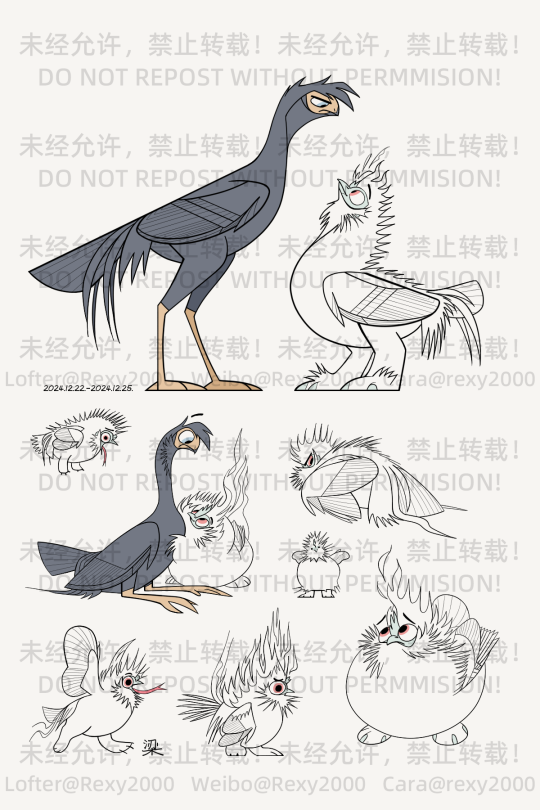
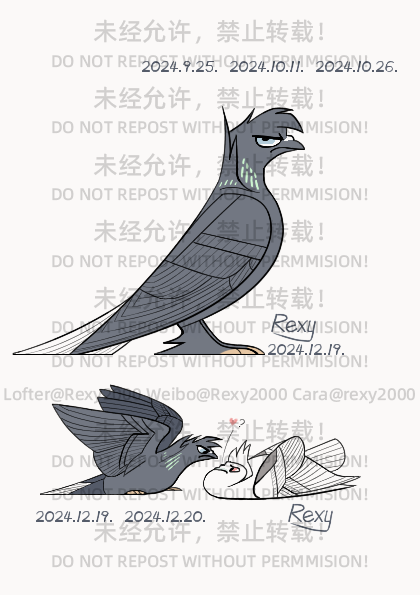
左图有另一个版本展示了丹尼尔跗蹠上有距,我没发过来。
The drawing on the left has another version that shows the spurs on Daniel's tarsometatarsi. I didn't post that version to this platform.
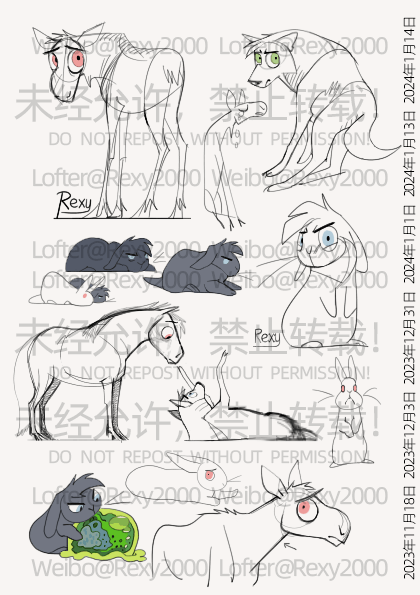
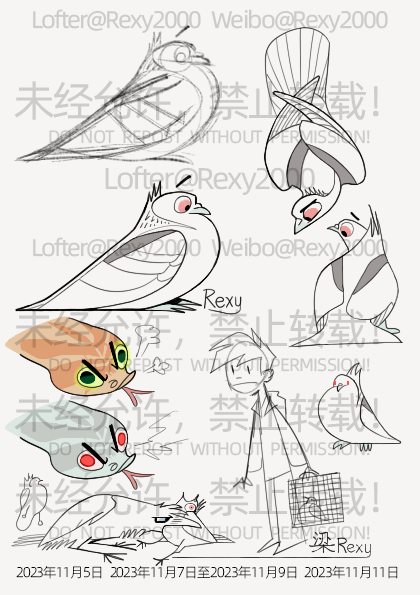
我给了丹幼鹿形态,刚开始给他画了肉垂,后来发现自己抓幼鹿特征不够准,幼鹿其实无肉垂。我想让丹伪装得更好,就改了他的设计。
I gave Dan a fawn form and drew a dewlap for him at first. Later I found that I didn't draw the fawn features accurately enough. In reality fawns don't have dewlaps. I wanted Dan's disguise to look more convincing so I changed his design.
外出时,丹尼尔将丹关在鸽笼里给自己提着,是考虑���了安全问题,没恶意。
Daniel keeps Dan in a pigeon cage to carry around when they are outdoor in order to keep his other self save. He doesn't bear ill will.
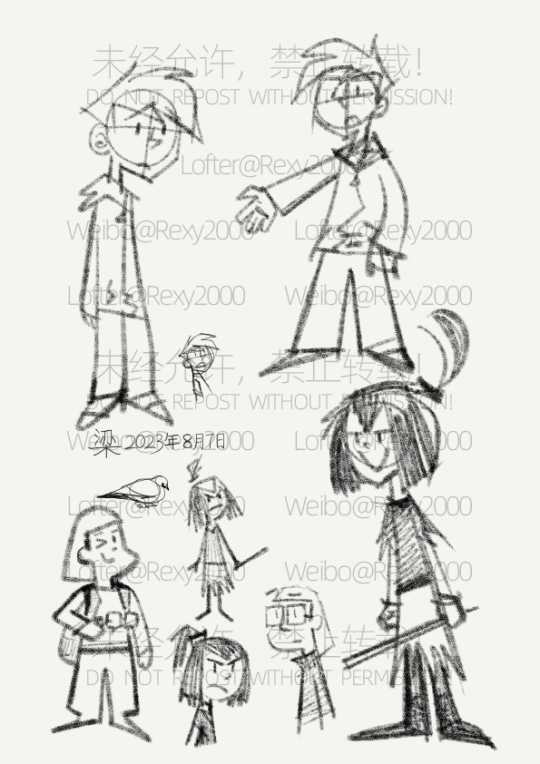
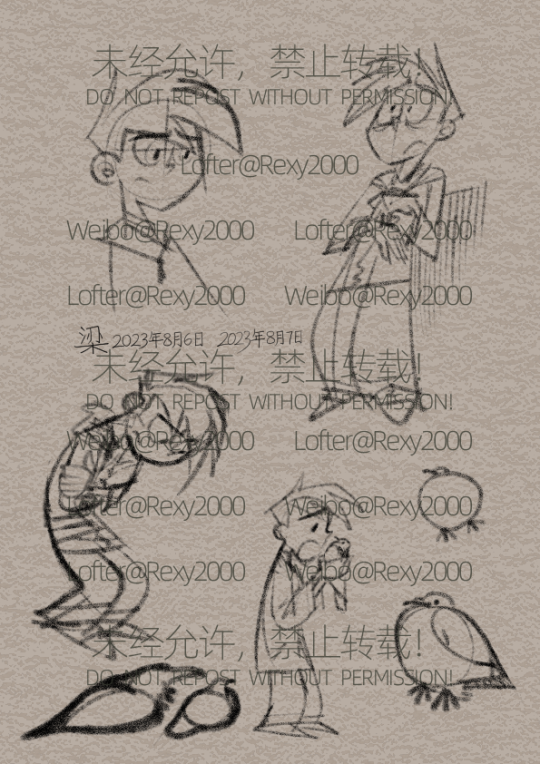
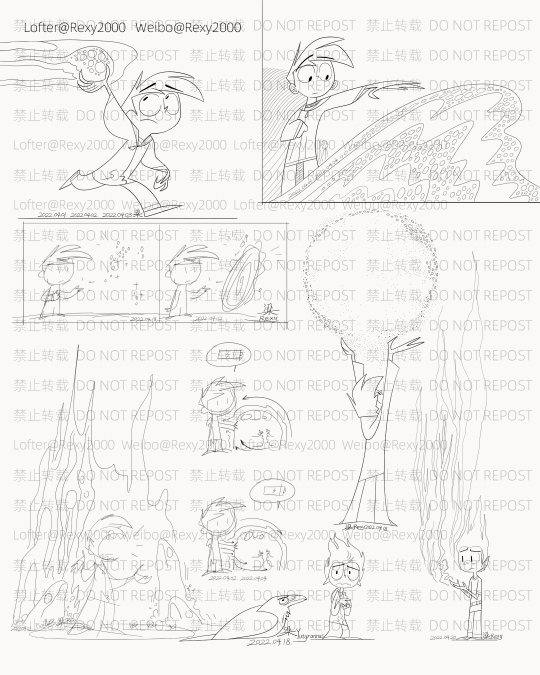
丹尼的能力。
Danny's abilities.
发布于2025年3月30日。
#I don't ship Daniel and Dan#Don't say I ship these two characters please#The drawings are not doodles though some of them are a bit sketchy#I want excuses to draw Danny and learn how to draw more species#Danny Phantom alternate universe#渡鸦之翼#Wings of the Ravens#Danny Fenton#Dark Danny#Dan Phantom#Sam Manson#Tucker Foley#original ghost characters#Liang Rexy's works#无厘头羽王龙
11 notes
·
View notes
Text
Porque eu criei esse blog
Meu objetivo ao entrar na plataforma é conseguir um espaço onde eu possa educar as pessoas sobre a alterhumanidade, mais especificamente, em português brasileiro!
Infelizmente muitas das informações de qualidade deixam de ser propriamente traduzidas, limitando seu acesso. Por conta disso, a imagem da theriantropia, e da alterhumanidade como um todo, não está completa ou bem representada na internet brasileira, e eu quero muito mudar isso!
Se você se identifica com a minha motivação, ou só tem curiosidade sobre o assunto, considere seguir esse blog, ou compartilhar ele por aí :)
Nada aqui é dito sem muita pesquisa e absoluta certeza, então você estará em boas "patas" ��
Quem sou eu
O meu nome é gremlin, sou um therian holotérico (além de mais identidades, como otherkin, fictionkin, entre outras) e vou listar meus types ao final do post
Sou fissurado pela alterhumanidade desde que fui introduzido ao assunto, e me descobri como alterhumano. Provavelmente é daí que bem meu desejo insaciável de educar as pessoas sobre ela, e mergulhar no assunto sempre que posso ^^'
Meus maiores hobbies são fazer minhas próprias gears, desenhar e jogar. Talvez eu poste comics ou artes sobre a theriantropia no futuro, mas não prometo nada :P
Minha kinlist
Paroulink:
Fada/metamorfo ("changeling")
Theriotypes:
Coiote (canis latrans)
Todos os felinos (felidae)
Sabiá da praia (mimus gilvus)
Dragão marinho (teriomítico)
Urso polar (ursus maritimus) - Questionando
Kintypes:
Lagomore
Centauro
Grifo
Hearttypes:
Cachorro (canis lupus familiaris)
Coelhos e lebres (leporidae)
Raposas (vulpes)
Chihiro Fujisaki (Danganronpa)
Freddy Fazbear (FNaF)
Ralsei (Deltarune)
Gato (Inscryption)
Linktypes:
Lobisomem
Lobo (canis lupus)
Cavalo (equus caballus)
Fictotypes:
V (Murder Drones)
Cyn (Murder Drones)
Kris (Deltarune)
Twilight Sparkle (MLP)
Noone (The Sounds of Nightmares)
Springtrap (FNaF)
"Ninguém" (Deltarune)
E com issso, chegamos ao fim da minha introdução. Seja bem vinde, e tenha um bom dia/tarde/noite! Espero que goste do meu blog :)
#therian#theriantropia#otherkin#alterhumanidade#alterhuman#nonhuman#holothere#intro#informação#brasil
25 notes
·
View notes
Text
The Deadlords / 十二人の魔将
The Deadlords refers to twelve undead warriors first serving under the Loptrians of Jugdral in Fire Emblem: Genealogy of the Holy War and Thracia 776, and were commanded by Validar and the Grimleal millennia later in Fire Emblem: Awakening. The title is rather straightforward; the Deadlords are the most powerful of the Risen, so them being referred as the lords of the dead denotes their strength.
The individual Deadlords are called Mus, Bovis, Tigris, Lepus, Draco, Anguilla, Equus, Ovis, Simia, Gallus, Canis and Porcus. These names invoke the Chinese Zodiac Animals, using Latin-based words to refer to the Mouse/Rat, Bull/Ox, Tiger, Rabbit, Dragon, Snake, Horse, Goat/Ram, Monkey, Rooster, Dog and Pig/Boar, respectively. The use of these names are likely derived from an old Chinese tale on how the Zodiac Animals were assigned. It is said that the Jade Emperor, the first god, wanted to see the creatures of the earth after ruling from Heaven without ever visiting Earth. The twelve animals that came to the gates of Heaven to see the Jade Emperor were given years to represent. A near-identical story is found in Buddhism, in which Siddhartha Gautama asked all animals to come to him before he ascended from Earth, but only twelve arrived. This could relate to the subservience of the Deadlords to Loptous/Julius/Validar.
In Japanese, the Deadlords are called 十二人の魔将 (rōmaji: jūniri no mashō) or 十二魔将 (rōmaji: jūni mashō), literally meaning "Twelve Demon Generals". This name comes from the Twelve Heavenly Generals (十二神将, rōmaji: jūni shinshō). In many East Asian forms of Buddhism, the Twelve Heavenly Generals are twelve yaksha, a type of guardian deity, that serve the buddha of healing and medicine, Bhaisajyaguru. Much like the name localizations of the individual members, the name seems to be based on the relationship between the Deadlords and their superior. The Twelve Heavenly Generals have also traditionally been associated with the Zodiac Animals, likely inspiring the English localization.
The individual members of the Deadlord share a different naming pattern in Japanese; they are instead called アインス (rōmaji: ainsu), ツヴァイ (rōmaji: tsuvai), ドライ (rōmaji: dorai), フィーア (rōmaji: fīa), フュンフ (rōmaji: fyunfu), ゼクス (rōmaji: zekusu), ズイーベン (rōmaji: zīben), アハト (rōmaji: ahato), ノイン (rōmaji: noin), ツェーン (rōmaji: tsēn), エルフ (rōmaji: erufu) and ツヴェルフ (rōmaji: tsuverufu). These correspond to the first twelve numbers in the German language: eins, zwei, drei, vier, fünf, sechs, sieben, acht, neun, zehn, elf and zwölf. Beyond the obvious connection of there being twelve Deadlords, the names relate to the German-based naming scheme in various military organizations in Jugdral, such as the Weiss Ritter of Belhalla, the Lance Ritter of Leonster, or the Welkenrosen of the Loptr Church. It could also be interpreted that by numbering the Deadlords, it dehumanizes the lives that had their bodies stolen for the Deadlords' use.
37 notes
·
View notes
Text

Walia ibex Capra walie
I love ibexes and this one is so dramatically coloured. Love their little stripey socks.
They are endemic to an itty bitty part of Ethiopia.
Digital zoo - in analog space, there is no captive population of these guys whatsoever.
You can look them up or go by vibes :D If you suggest something else and it doesn’t win, I’ll add it to my list for the future!
5 notes
·
View notes
Text
All animal species (and a couple algae) that have kept the same scientific name since Linnaeus
The first work of taxonomy that is considered as having any scientific authority for animal species was the 10th edition of Linnaeus' Systema Naturae, published in 1758. (Also a book on spiders called Aranei Suecici, published one year before.) That's the foundational text of the binominal system of nomenclature of species still in use today. Since then most of Linnaeus' original species (4379 species, of which 185 mammals, 554 birds, 217 "amphibians" (including reptiles and cartilaginous fish), 379 fishes, 2104 "insects" (including various arthropods, of which 664 are beetles and 543 are moths & butterflies crammed into only 3 genera), and 940 "worms" (including basically all other invertebrates, and even some protists and algae)) have been dismembered, renamed, or at least moved to different genera (e.g. the house sparrow went from Fringilla domestica to Passer domesticus).
Here is a list of all of Linnaeus' original species from 1758 that still retain their original name. I believe they are 484 in total.
"Mammalia"
(Primates)
Homo sapiens (human)
Lemur catta (ring-tailed lemur)
Vespertilio murinus (rearmouse bat)
(Bruta)
Elephas maximus (Asian elephant)
Trichechus manatus (West Indian manatee)
Bradypus tridactylus (three-toed sloth)
Myrmecophaga tridactyla (giant anteater)
Manis pentadactylus (Chinese pangolin)
(Ferae)
Phoca vitulina (harbor seal)
Canis familiaris (dog)
Canis lupus (grey wolf)
Felis catus (house cat)
Viverra zibetha (Indian civet)
Mustela erminea (stoat)
Mustela furo (ferret)
Mustela lutreola (European mink)
Mustela putorius (wild ferret)
Ursus arctos (brown bear)
(Bestiae)
Sus scrofa (wild boar/pig)
Dasypus septemcinctus (seven-banded armadillo)
Dasypus novemcinctus (nine-banded armadillo)
Erinaceus europaeus (European hedgehog)
Talpa europaea (European mole)
Sorex araneus (common shrew)
Didelphis marsupialis (common opossum)
(Glires)
Rhinoceros unicornis (Indian rhinoceros)
Hystrix brachyura (Malayan porcupine)
Hystrix cristata (crested porcupine)
Lepus timidus (common hare)
Castor fiber (European beaver)
Mus musculus (house mouse)
Sciurus vulgaris (red squirrel)
(Pecora)
Camelus dromedarius (dromedary camel)
Camelus bactrianus (Asian camel)
Moschus moschiferus (musk deer)
Cervus elaphus (red deer)
Capra hircus (goat)
Capra ibex (Alpine ibex)
Ovis aries (sheep)
Bos taurus (cow)
Bos indicus (zebu)
(Belluae)
Equus caballus (horse)
Equus asinus (donkey)
Equus zebra (mountain zebra)
Hippopotamus amphibius (hippopotamus)
(Cete)
Monodon monoceros (narwhal)
Balaena mysticetus (bowhead whale)
Physeter macrocephalus (sperm whale)
Delphinus delphis (common dolphin)
"Aves"
(Accipitres)
Vultur gryphus (Andean condor)
Falco tinnunculus (common kenstrel)
Falco sparverius (sparrowhawk)
Falco columbarius (pigeonhawk)
Falco subbuteo (Eurasian hobby)
Falco rusticolus (gyrfalcon)
Strix aluco (tawny owl)
Lanius excubitor (great grey shrike)
Lanius collurio (red-backed shrike)
Lanius schach (long-tailed shrike)
(Picae)
Psittacus erithacus (grey parrot)
Ramphastos tucanus (white-throated toucan)
Buceros bicornis (great hornbill)
Buceros rhinoceros (rhinoceros hornbill)
Crotophaga ani (smooth-billed ani)
Corvus corax (raven)
Corvus corone (carrion crow)
Corvus frugilegus (rook)
Corvus cornix (hooded crow)
Coracias oriolus (golden oriole)
Coracias garrulus (European roller)
Gracula religiosa (hill myna)
Paradisaea apoda (greater bird-of-paradise)
Cuculus canorus (common cuckoo)
Jynx torquilla (wryneck)
Picus viridis (green woodpecker)
Sitta europaea (Eurasian nuthatch)
Merops apiaster (European bee-eater)
Merops viridis (blue-throated bee-eater)
Upupa epops (Eurasian hoopoe)
Certhia familiaris (Eurasian treecreeper)
Trochilus polytmus (red-billed streamertail hummingbird)
(Anseres)
Anas platyrhynchos (mallard duck)
Anas crecca (teal duck)
Mergus merganser (common merganser)
Mergus serrator (red-breasted merganser)
Alca torda (razorbill auk)
Procellaria aequinoctialis (white-chinned petrel)
Diomedea exulans (wandering albatross)
Pelecanus onocrotalus (great white pelican)
Phaeton aethereus (red-billed tropicbird)
Larus canus (common gull)
Larus marinus (great black-backed gull)
Larus fuscus (lesser black-backed gull)
Sterna hirundo (common tern)
Rhynchops niger (black skimmer)
(Grallae)
Phoenicopterus ruber (American flamingo)
Platalea leucorodia (Eurasian spoonbill)
Platalea ajaia (roseate spoonbill)
Mycteria americana (wood stork)
Ardea cinerea (grey heron)
Ardea herodias (blue heron)
Ardea alba (great egret)
Scolopax rusticola (Eurasian woodcock)
Charadrius hiaticula (ringed plover)
Charadrius alexandrinus (Kentish plover)
Charadrius vociferus (killdeer plover)
Charadrius morinellus (Eurasian dotterel)
Recurvirostra avosetta (pied avocet)
Haematopus ostralegus (Eurasian oystercatcher)
Fulica atra (Eurasian coot)
Rallus aquaticus (water rail)
Psophia crepitans (grey-winged trumpeter)
Otis tarda (great bustard)
Struthio camelus (ostrich)
(Gallinae)
Pavo cristatus (Indian peafowl)
Meleagris gallopavo (wild turkey)
Crax rubra (great curassow)
Phasianus colchicus (common pheasant)
Tetrao urogallus (western capercaillie)
(Passeres)
Columba oenas (stock dove)
Columba palumbus (wood pigeon)
Alauda arvensis (Eurasian skylark)
Sturnus vulgaris (European starling)
Turdus viscivorus (mistle thrush)
Turdus pilaris (fieldfare thrush)
Turdus iliacus (redwing thrush)
Turdus plumbeus (red-legged thrush)
Turdus torquatus (ring ouzel)
Turdus merula (blackbird)
Loxia curvirostra (crossbill)
Emberiza hortulana (ortolan bunting)
Emberiza citrinella (yellowhammer)
Emberiza calandra (corn bunting)
Fringilla coelebs (common chaffinch)
Motacilla alba (white wagtail)
Motacilla lava (yellow wagtail)
Parus major (great tit)
Hirundo rustica (barn swallow)
Caprimulgus europaeus (European nightjar)
"Amphibia"
(Reptiles)
Testudo graeca (Greek tortoise)
Draco volans (flying dragon)
Lacerta agilis (sand lizard)
Rana temporaria (common frog)
(Serpentes)
Crotalus horridus (timber rattlesnake)
Crotalus durissus (tropical rattlesnake)
Boa constrictor (common boa)
Coluber constrictor (eastern racer)
Anguis fragilis (slowworm)
Amphisbaena alba (red worm lizard)
Caecilia tentaculata (white-bellied caecilian)
(Nantes)
Petromyzon marinus (sea lamprey)
Raja clavata (thornback ray)
Raja miraletus (brown ray)
Squalus acanthias (spiny dogfish)
Chimaera monstrosa (rabbitfish)
Lophius piscatorius (anglerfish)
Acipenser sturio (sea sturgeon)
Acipenser ruthenus (sterlet sturgeon)
"Pisces"
(Apodes)
Muraena helena (Mediterranean moray)
Gymnotus carapo (banded knifefish)
Trichiurus lepturus (cutlassfish)
Anarhichas lupus (Atlantic wolffish)
Ammodytes tobianus (lesser sandeel)
Xiphias gladius (swordfish)
Stromateus fiatola (blue butterfish)
(Jugulares)
Callionymus lyra (common dragonet)
Uranoscopus scaber (stargazer)
Trachinus draco (greater weever)
Gadus morhua (Atlantic cod)
Blennius ocellaris (butterfly blenny)
Ophidion barbatum (snake cusk-eel)
(Thoracici)
Cyclopterus lumpus (lumpsucker)
Echeneis naucrates (sharksucker)
Coryphaena equiselis (pompano)
Coryphaena hippurus (dorado)
Gobius niger (black goby)
Govius paganellus (rock goby)
Cottus gobio (European bullhead)
Scorpaena porcus (black scorpionfish)
Scorpaena scrofa (red scorpionfish)
Zeus faber (John Dory)
Pleuronectes platessa (European plaice)
Chaetodon striatus (banded butterflyfish)
Chaetodon capistratus (foureye butterflyfish)
Sparus aurata (gilt-head bream)
Labrus merula (brown wrasse)
Labrus mixtus (cuckoo wrasse)
Labrus viridis (green wrasse)
Sciaena umbra (brown meagre)
Perca fluviatilis (European perch)
Gasterosteus aculeatus (three-spined stickleback)
Scomber scombrus (Atlanti mackerel)
Mullus barbatus (red mullet)
Mullus surmuletus (surmullet)
Trigla lyra (piper gurnard)
(Abdominales)
Cobitis taenia (spined loach)
Silurus asotus (Amur catfish)
Silurus glanis (Wels catfish)
Loricaria cataphracta (suckermouth catfish)
Salmo carpio (Garda trout)
Salmo trutta (brown trout)
Salmo salar (Atlantic salmon)
Fistularia tabacaria (bluespotted cornetfish)
Esox lucius (northern pike)
Argentina sphyraena (European argentine)
Atherina hepsetus (Mediterranean sand smelt)
Mugil cephalus (flathead mullet)
Exocoetus volitans (tropical flying fish)
Polynemus paradiseus (Paradise threadfin)
Clupea harengus (Atlantic herring)
Cyprinus carpio (common carp)
(Branchiostegi)
Mormyrus caschive (bottlenose elephantfish)
Balistes vetula (queen triggerfish)
Ostracion cornutus (longhorn cowfish)
Ostracion cubicus (yellow boxfish)
Tetraodon lineatus (Fahaka pufferfish)
Diodon hystrix (spot-fin porcupinefish)
Diodon holocanthus (long-spine porcupinefish)
Centriscus scutatus (grooved shrimpfish)
Syngnathus acus (common pipefish)
Syngnathus pelagicus (pelagic pipefish)
Syngnathus typhle (broad-nosed pipefish)
Pegasus volitans (longtail seamoth)
"Insecta"
(Coleoptera)
Scarabaeus sacer (sacred scarab)
Dermestes lardarius (larder beetle)
Dermestes murinus (larder beetle)
Hister unicolor (clown beetle)
Hister quadrimaculatus (clown beetle)
Silpha obscura (carrion beetle)
Cassida viridis (tortoise beetle)
Cassida nebulosa (tortoise beetle)
Cassida nobilis (tortoise beetle)
Coccinella trifasciata (ladybug)
Coccinella hieroglyphica (ladybug) [Coccinella 5-punctata, 7-punctata, 11-punctata, and 24-punctata survive as quinquepunctata, septempunctata, undecimpunctata, and vigintiquatorpunctata]
Chrysomela populi (leaf beetle)
Chrysomela lapponica (leaf beetle)
Chrysomela collaris (leaf beetle)
Chrysomela erythrocephala (leaf beetle)
Curculio nucum (nut weevil)
Attelabus surinamensis (leaf-rolling weevil)
Cerambyx cerdo (capricorn beetle)
Leptura quadrifasciata (longhorn beetle)
Cantharis fusca (soldier beetle)
Cantharis livida (soldier beetle)
Cantharis oscura (soldier beetle)
Cantharis rufa (soldier beetle)
Cantharis lateralis (soldier beetle)
Elater ferrugineus (rusty click beetle)
Cicindela campestris (green tiger beetle)
Cicindela sylvatica (wood tiger beetle)
Buprestis rustica (jewel beetle) [Buprestis 8-guttata survives as octoguttata]
Dytiscus latissimus (diving beetle)
Carabus coriaceus (ground beetle)
Carabus granulatus (ground beetle)
Carabus nitens (ground beetle)
Carabus hortensis (ground beetle)
Carabus violaceus (ground beetle)
Tenebrio molitor (mealworm)
Meloe algiricus (blister beetle)
Meloe proscarabaeus (blister beetle)
Meloe spec (blister beetle)
Mordela aculeata (tumbling glower beetle)
Necydalis major (longhorn beetle)
Staphylinus erythropterus (rove beetle)
Forficula auricularia (common earwig)
Blatta orientalis (Oriental cockroach)
Gryllus campestris (field cricket)
(Hemiptera)
Cicada orni (cicada)
Notonecta glauca (backswimmer)
Nepa cinerea (water scorpion)
Cimex lectularius (bedbug)
Aphis rumici (black aphid)
Aphis craccae (vetch aphid)
Coccus hesperidum (brown scale insect)
Thrips physapus (thrips)
Thrips minutissimum (thrips)
Thrips juniperinus (thrips)
(Lepidoptera)
Papilio paris (Paris peacock butterfly)
Papilio helenus (red Helen butterfly)
Papilio troilus (spicebush swallowtail butterfly)
Papilio deiphobus (Deiphobus swallowtail butterfly)
Papilio polytes (common Mormon butterfly)
Papilio glaucus (eastern tiger swallowtail butterfly)
Papilio memnon (great Mormon butterfly)
Papilio ulysses (Ulysses butterfly)
Papilio machaon (Old World swallowtail butterfly)
Papilio demoleus (lime swallowtail butterfly)
Papilio nireus (blue-banded swallowtail butterfly)
Papilio clytia (common mime butterfly)
Sphinx ligustri (privet hawk-moth)
Sphinx pinastri (pine hawk-moth) [genus Phalaena was suppressed, but seven subgenera created by Linnaeus are now valid as genera]
(Neuroptera)
Libellula depressa (chaser dragonfly)
Libellula quadrimaculata (four-spotted skimmer dragonfly)
Ephemera vulgata (mayfly)
Phryganea grandis (caddisfly)
Hemerobius humulinus (lacewing)
Panorpa communis (scorpionfly)
Panorpa germanica (scorpionfly)
Raphidia ophiopsis (snakefly)
(Hymenoptera)
Cynips quercusfolii (oak gall wasp)
Tenthredo atra (sawfly)
Tenthredo campestris (sawfly)
Tenthredo livida (sawfly)
Tenthredo mesomela (sawfly)
Tenthredo scrophulariae (sawfly)
Ichneumon extensorius (parasitoid wasp)
Ichneumon sarcitorius (parasitoid wasp)
Sphex ichneumoneus (digger wasp)
Vespa crabro (European hornet)
Apis mellifera (honey bee)
Formica fusca (silky ant)
Mutilla europaea (large velvet ant)
(Diptera)
Oestrus ovis (sheep botfly)
Tipula oleracea (marsh cranefly)
Tipula hortorum (cranefly)
Tipula lunata (cranefly)
Musca domestica (housefly)
Tabanus bovinus (pale horsefly)
Tabanus calens (horsefly)
Tabanus bromius (brown horsefly)
Tabanus occidentalis (horsefly)
Tabanus antarcticus (horsefly)
Culex pipiens (house mosquito)
Empis borealis (dance fly)
Empis pennipes (dance fly)
Empis livida (dance fly)
Conops flavipes (thick-headed fly)
Asilus barbarus (robberfly)
Asilus crabroniformis (hornet robberfly)
Bombylius major (bee fly)
Bombylius medius (bee fly)
Bombylius minor (bee fly)
Hippobosca equina (forest fly)
(Aptera)
Lepisma saccharina (silverfish)
Podura aquatica (water springtail)
Termes fatale (termite)
Pediculus humanus (human louse)
Pulex irritans (human flea)
Acarus siro (flour mite)
Phalangium opilio (harvestman)
Araneus angulatus (orb-weaving spider)
Araneus diadematus (European garden spider)
Araneus marmoreus (marbled orbweaver)
Araneus quadratus (four-spotted orbweaver -- last four are by Clerck 1757, some of the very few surviving pre-Linnean names!)
Scorpio maurus (large-clawed scorpion)
Cancer pagurus (brown crab)
Oniscus asellus (common woodlouse)
Scolopendra gigantea (giant centipede)
Scolopendra morsitans (red-headed centipede)
Julus fuscus (millipede)
Julus terrestris (millipede)
"Vermes"
(Intestina)
Gordius aquaticus (horsehair worm)
Lumbricus terrestris (common earthworm)
Ascaris lumbricoides (giant roundworm)
Fasciola hepatica (liver fluke)
Hirudo medicinalis (medicinal leech)
Myxine glutinosa (Atlantic hagfish)
Teredo navalis (shipworm)
[shout out to Furia infernalis, a terrifying carnivorous jumping worm that Linnaeus described, but which doesn't seem to actually exist]
(Mollusca)
Limax maximus (leopard slug)
Doris verrucosa (warty nudibranch)
Nereis caerulea (ragworm)
Nereis pelagica (ragworm)
Aphrodita aculeata (sea mouse)
Lernaea cyprinacea (anchor worm)
Scyllaea pelagica (Sargassum nudibranch)
Sepia officinalis (common cuttlefish)
Asterias rubens (common starfish)
Echinus esculentus (edible sea urchin)
(Testacea)
Chiton tuberculatus (West Indian green chiton)
Lepas anatifera (goose barnacle)
Pholas dactylus (common piddock)
Mya arenaria (softshell clam)
Mya truncata (truncate softshell)
Solen vagina (razor clam)
Tellina laevigata (smooth tellin)
Tellina linguafelis (cat-tongue tellin)
Tellina radiata (sunrise tellin)
Tellina scobinata (tellin)
Cardium costatum (ribbed cockle)
Donax cuneatus (wedge clam)
Donas denticulatus (wedge clam)
Donax trunculus (wedge clam)
Venus casina (Venus clam)
Venus verrucosa (warty venus)
Spondylus gaederopus (thorny oyster)
Spondylus regius (thorny oyster)
Chama lazarus (jewel box shell)
Chama gryphoides (jewel box shell)
Arca noae (Noah's ark shell)
Ostrea edulis (edible oyster)
Anomia aurita (saddle oyster)
Anomia ephippium (saddle oyster)
Anomia hysterita (saddle oyster)
Anomia lacunosa (saddle oyster)
Anomia spec (saddle oyster)
Anomia striatula (saddle oyster)
Mytilus edulis (blue mussel)
Pinna muricata (pen shell)
Pinna nobilis (fan mussel)
Pinna rudis (rough pen shell)
Argonauta argo (argonaut)
Nautilus pompilius (chambered nautilus)
Conus ammiralis (admiral cone snail)
Conus aulicus (princely cone snail)
Conus aurisiacus (cone snail)
Conus betulinus (betuline cone snail)
Conus bullatus (bubble cone snail)
Conus capitaneus (captain cone snail)
Conus cedonulli (cone snail)
Conus ebraeus (black-and-white cone snail)
Conus figulinus (fig cone snail)
Conus genuanus (garter cone snail)
Conus geographus (geographer cone snail)
Conus glaucus (glaucous cone snail)
Conus granulatus (cone snail)
Conus imperialis (imperial cone snail)
Conus litteratus (lettered cone snail)
Conus magus (magical cone snail)
Conus marmoreus (marbled cone snail)
Conus mercator (trader cone snail)
Conus miles (soldier cone snail)
Conus monachus (monastic cone snail)
Conus nobilis (noble cone snail)
Conus nussatella (cone snail)
Conus princeps (prince cone snail)
Conus spectrum (spectrecone snail)
Conus stercusmuscarum (fly-specked cone snail)
Conus striatus (striated cone snail)
Conus textile (cloth-of-gold cone snail)
Conus tulipa (tulip cone snail)
Conus varius (freckled cone snail)
Conus virgo (cone snail)
Cypraea tigris (tiger cowry shell)
Bulla ampulla (Pacific bubble shell)
Voluta ebraea (Hebrew volute)
Voluta musica (music volute)
Buccinum undatum (common whelk)
Strombus pugilis (fighting conch)
Murex tribulus (caltrop murex)
Trochus maculatus (maculated top shell)
Turbo acutangulus (turban shell)
Turbo argyrostomus (silver-mouth turban shell)
Turbo chrystostomus (gold-mouth turban shell)
Turbo marmoratus (green turban shell)
Turbo petholatus (turban shell)
Turbo sarmaticus (giant turban shell)
Helix lucorum (Mediterranean snail)
Helix pomatia (Roman snail)
Nerita albicilla (blotched nerite)
Nerita chamaeleon (nerite)
Nerita exuvia (snakeskin nerite)
Nerita grossa (nerite)
Nerita histrio (nerite)
Nerita peloronta (bleeding tooth)
Nerita plicata (nerite)
Nerita polita (nerite)
Nerita undata (nerite)
Haliotis asinina (ass-ear abalone)
Haliotis marmorata (marbled abalone)
Haliotis midae (South African abalone)
Haliotis parva (canaliculate abalone)
Haliotis tuberculata (green ormer)
Haliotis varia (common abalone)
Patella caerulea (Mediterranean limpet)
Patella pellucida (blue-rayed limpet)
Patella vulgata (European limpet)
Dentalium elephantinum (elephant tusk)
Dentalium entale (tusk shell)
[genus Serpula is still in use with none of its original species]
(Lithophyta)
Tubipora musica (organ pipe coral)
Millepora alcicornis (sea ginger fire coral)
Madrepora oculata (zigzag stone coral)
(Zoophyta)
Isis hippuris (sea bamboo)
Isis ochracea (sea bamboo)
Gorgonia flabellum (Venus fan)
Gorgonia ventalina (purple sea fan)
Alcyonium bursa (soft coral)
Alcyonium digitatum (dead man's fingers)
Tubularia indivisa (oaten ipes hydroid)
Corallina officinalis (coralline red alga)
Sertularia argentea (sea fern)
Sertularia cupressoides (hydroid)
Pennatula phosphorea (sea pen)
Taenia solium (pork tapeworm)
Volvox globator (colonial alga)
[genus Hydra is still in use with none of its original species]
15 notes
·
View notes
Text
Nacht has a lot of different looks so I want to know what you guys think is the best of them.
Also I’m considering this poll a victory lap after Nacht got the fewest votes in @thoughtfullyrainynightmare’s “worst BC outfit” poll.
#black clover#nacht faust#happy birthday Nacht#soda asides#poll#personally i think nacht running around the battlefield without a shirt was his best look/lh+j#maybe i'm joking... maybe i'm not...
40 notes
·
View notes
Text
FE Miniboss Battle Final
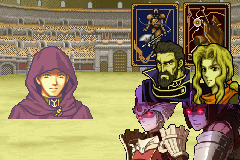
info and propaganda under the cut
DENNING
Class: Sniper
Appears in: Blazing Blade - Chapter 29 (Eliwood)/31 (Hector)
Choice quote: "This is a message from Lord Nergal. 'I await you on the Dread Isle.'"
Propaganda:
“This is a message from Lord Nergal. 'I await you on the Dread Isle.'"
THE DEADLORDS
Class: Baron/General (Mus) ; Hero/Bow Knight (Bovis) ; Warrior (Tigris) ; High Priest/War Cleric (Lepus) ; War Mage/Dark Knight (Anguilla) ; Bishop/Paladin (Equus) ; Sage (Ovis) ; Swordmaster (Simia) ; Dark Bishop/Sorcerer (Gallus) ; Priestess/Sage/Valkyrie (Canis) ; Rogue/Assassin (Porcus)
Appear in: Genealogy of the Holy War - Endgame ; Thracia 776 - Endgame ; Awakening - Chapter 22
Choice quote: "WE ARE THE DEADLORDS. WE DO NOT SUCCUMB TO MORTAL EMOTION." (Equus, Infinite Regalia DLC)
Propaganda: (1)
16 notes
·
View notes
Text
🌕 🌖 🌗 🌘 🌑 🌒 🌓 🌔 🌕

Hey there! My name is Luna, you can also call me Moon. I'm a primarily spiritual therian and otherhearted. I awakened in 2012. My main blog is @iridescentclaws so likes and follows come from there.
You can find my tag list here. And if you're looking to submit a request, check out my guidelines here.
Also, consider joining the Equidae Discord! An Equine Alterhuman community!

About Me
As I stated before, I'm primarily a spiritual therian. I believe my soul is nonhuman. That my theriotypes are different forms of my true self. This blog is one way I cope with my species dysphoria, I post about myself and my experiences as a therian.

(↑ Art by me)
As a seal, I am a harp seal pup (Pagophilus Groendlandicus) in the white coat stage. I don't have any distinct features, just the usual white fur. Black snout, whiskers/whisker spots, claws and eyes.

(↑ Art by me)
As a wolf, I am a black and beige/cream Northwestern wolf with greenish yellow (Canis Lupus Occidentalis). I think of pretty average size? Might be a little on the smaller side. Also, It's most likely influenced by my life now as a human, but I do have a lot of dog-like behaviors which I've picked up.
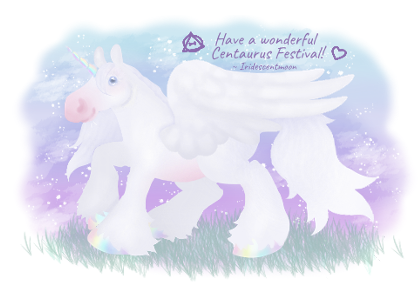
(↑ Art by me)
As an alicorn, I'm really just a horse (Equus Caballus) but with a unicorn horn and feathered wings. I know very little about this side of myself besides whatever I can intuit or just what I feel sounds right. I look very much like an Irish Cob but I'm about as tall as a Clydesdale (About 6ft at the shoulder). All of my fur and hair is white, my eyes are light blue, and my horn and hooves opalescent/pearlescent. I have no idea if there are any more define features/behaviors. It can be hard to tell as I have a lot of overlapping phantom and sometimes mental shifts.
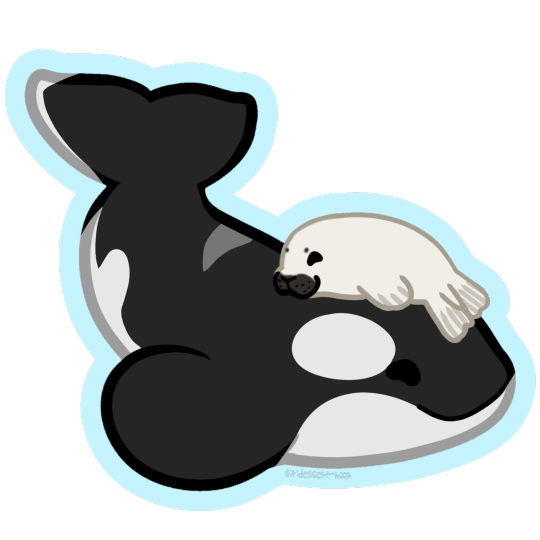
(↑ Art by me)
Lastly, I am orca & cat hearted. While I do not identify as either an orca or cat, I do sometimes experience shifts of either. My connection to orcas is inexplicably spiritual but my connection to cats I would say is almost purely psychological. Regardless, both species are like family to me and they are very important to me. I don't feel any particular connection to any ecotype or breed, it's just as a species.
I do also have some past lives that I consider kardiatypes or just important to me in general, but I don't really have very much info yet. I do feel I was a big drake living somewhere Northern and snowy at some point. Anything else is more or less unconfirmed.

Also, I don't feel comfortable with KFF following me. And I'm not comfortable with the term "kinnie". I cannot and will not stop anyone for using the term. I just would rather not be called it due to it's history and similarity to the transphobic slur.
19 notes
·
View notes
Text
[ID: a presentation on domestic animals and what makes them domestic.
The first image contains text defining domestic animals as the ones that "have been selectively bred by humans for many generations to the point where they are genetically different from their wild ancestors". It also elaborates the difference between feral and genuinely wild animalsanimals, and tells that feral animals can be harmful for the environment they are released into, as well as that wild animals are less ethical pets than domestic ones.
The following images are about particular animals. Each contains the common English and scientific Latin names and a picture for the domestic animal and its wild ancestor, as well basic information on when and where it was domesticated and purposes for which it is being bred.
It covers:
Domestic Dog (Canis familiaris). Bred for: hunting, herding, pulling loads, protection, guarding livestock, racing, blood sport, meat, companionship, scientific research, show. Breeds: ~360. Domesticated in: ~13, 000 BC Siberia. Wild ancestor: Pleistocene Wolf (Canis lupus).
Domestic Cat (Felis catus). Bred for: pest control, companionship, scientific research, show. Breeds:~73. Domesticated in: ~7,500 BC Western Asia. Wild ancestor: African Wildcat (Felis lybica).
Ferret (Mustela furo). Bred for: hunting rabbits, companionship, scientific research. Breeds: 1. Domesticated in: ~500 BC Mediterranean Region. Wild ancestor: European Polecat (Mustela putorius).
Cattle (Bos taurus). Bred for: meat, milk, hides, pack, riding, driving, blood sport, companionship. Breeds: ~1000. Domesticated in: ~8,500 BC Mediterranean Region and India. Wild ancestor: Aurochs (Bos primigenius)(extinct) .
Sheep (Ovis aries). Bred for: meat, milk, skin, wool. Breeds: ~1000. Domesticated in: 11, 000~9, 000 BC Mesopotamia. Wild ancestor: Mouflon (Ovis gmelini).
Goat (Capra hircus). Bred for: meat, milk, skin, hair, companionship. Breeds: ~300. Domesticated in: ~8, 000 BC Iran. Wild ancestor: Wild Goat (Capra aegagrus).
Horse (Equus ferus caballus). Bred for: pack, riding, driving, meat, hair, racing, companionship. Breeds: ~300. Domesticated in: ~8, 000 BC Eurasia. Wild ancestor: Wild Horse (Equus ferus) (extinct).
Donkey (Equus asinus). Bred for: pack, riding, driving, guarding livestock, companionship. Breeds: ~100. Domesticated in: 5,000~3, 000 BC Nubia. Wild ancestor: African Wild Ass (Equus africanus) (critically endangered).
Dromedary Camel (Camelus dromedarius). Bred for: pack, riding, meat, milk. Breeds: 1. Domesticated in: 4,000~2, 000 BC Arabia. Wild ancestor: Wild Dromedary Camel (Camelus dromedarius?) (extinct).
Bactrian Camel (Camelus bactrianus). Bred for: pack, riding, meat, milk, wool. Breeds: 1. Domesticated in: ~4,500 BC Mongolia and China. Wild ancestor: Unknown (extinct).
Llama (Lama glama). Bred for: pack, meat, fiber, guarding livestock. Breeds: 1. Domesticated in: 5,000~4, 000 BC Peru. Wild ancestor: Guanaco (Lama guanicoe).
Alpaca (Lama pacos). Bred for: fiber. Breeds: 2. Domesticated in: 5,000~4, 000 BC Peru. Wild ancestor: Vicuna (Lama vicugna).
Domestic Rabbit (Oryctolagus cuniculus domesticus). Bred for: meat, fur, companionship, scientific research. Breeds: ~300. Domesticated in: 1~1, 500 AD Rome. Wild ancestor: European Rabbit (Oryctolagus cuniculus).
Guinea Pig (Cavia porcellus). Bred for: meat, companionship, scientific research. Breeds: 14. Domesticated in: ~5, 000 BC Andean Region. Wild ancestor: Montane Guinea Pig (Cavia tschudii).
Fancy Rat (Rattus norvegicus domestica). Bred for: blood sport, companionship, scientific research, show. Breeds: 1. Domesticated in: ~1750 AD Europe. Wild ancestor: Brown Rat (Rattus norvegicus).
Fancy Mouse (Mus musculus domestica). Bred for: show, scientific research, companionship. Breeds: 1. Domesticated in: ~1, 000 BC China. Wild ancestor: House Mouse (Mus musculus).
Pig (Sus domesticus). Bred for: meat, companionship, scientific research. Breeds: ~300. Domesticated in: ~9, 000 BC Mesopotamia and ~6, 000 BC China. Wild ancestor: Wild Boar (Sus scrofa).
Domestic Pigeon (Columbia livia domestica). Bred for: meat, message carrying, racing, show, companionship. Breeds: ~800. Domesticated in: ~8, 000 BC Mesopotamia. Wild ancestor: Rock Dove (Columbia livia).
Domestic Turkey (Meleagris gallopavo domesticus). Bred for: meat. Breeds: ~21. Domesticated in: ~12 AD Mexico. Wild ancestor: Wild Turkey (Meleagris gallopavo).
Chicken (Gallus gallus domesticus). Bred for: meat, eggs, show, companionship. Breeds: ~100. Domesticated in: ~6, 000 BC Southeast Asia. Wild ancestor: Red Junglefowl (Gallus gallus).
Domestic Duck (Anas platyrhynhos domesticus). Bred for: meat, eggs, show, companionship. Breeds: ~220. Domesticated in: 600~500 BC China. Wild ancestor: Mallard (Anas platyrhynhos).
Domestic Muscovy Duck (Cairina moschata domestica). Bred for: meat. Breeds: 1. Domesticated in: ~50 AD Peru. Wild ancestor: Muscovy Duck (Cairina moschata).
Domestic Goose (Anser anser domesticus). Bred for: eggs, meat, feathers, guarding livestock, companionship. Breeds: ~30. Domesticated in: 3,000~1, 980 BC Egypt. Wild ancestor: Greylag Goose (Anser anser).
Chinese Goose/African Goose (Anser cygnoides domesticus). Bred for: eggs, meat, feathers. Breeds: 2. Domesticated in: 1,000 BC~1800 AD China. Wild ancestor: Swan Goose (Anser cygnoides).
Coturnix Quail (Coturnix japonica). Bred for: song, eggs, meat. Breeds: 11. Domesticated in: ~1, 200 AD Japan. Wild ancestor: Japanese Quail (Coturnix japonica).
Domestic Guineafowl (Numida meleagris). Bred for: pest control, guarding livestock, meat, eggs. Breeds: 1. Domesticated in: ~500 BC West Africa. Wild ancestor: Helmeted Guineafowl (Numida meleagris).
Domestic Canary (Serinus canaria domestica). Bred for: song, display, CO detection, companionship. Breeds: ~200. Domesticated in: ~1650 AD Europe. Wild ancestor: Atlantic Canary (Serinus canaria).
Axolotl (Ambystoma mexicanum). Bred for: scientific research, meat, display. Breeds: 1. Domesticated in: ~1879 AD France. Wild ancestor: Wild Axolotl (Ambystoma mexicanum) (critically endangered).
Siamese Fighting Fish/Betta (Betta splendens). Bred for: blood sport, display. Breeds: 1. Domesticated in: ~1020 AD Thailand. Wild ancestor: Siamese Fighting Fish/Betta (Betta splendens).
Goldfish (Carassius auratus). Bred for: display. Breeds: ~200. Domesticated in: ~1020 AD China. Wild ancestor: Crucian Carp (Carassius carassius).
Domestic Silk Moth (Bombyx mori). Bred for: silk. Breeds: 1. Domesticated in: ~3, 000 BC China. Wild ancestor: Wild Silk Moth (Bombyx mandarina).
Western Honey Bee (Apis mellifera). Bred for: crop pollination, honey, beeswax. Breeds: 1. Domesticated in: 7,000~3, 000 BC Egypt. Wild ancestor: European Honey Bee (Apis mellifera).
The last image is explaining what a breed is ("is was selectively bred by humans to look and/or behave a certain way"), and tells some breeds are less ethical than the others due to being bred for aesthetics at the expense of health.
End ID. ]

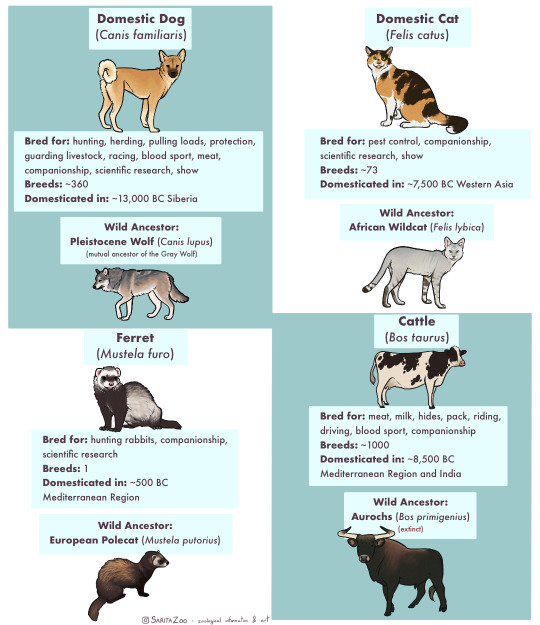


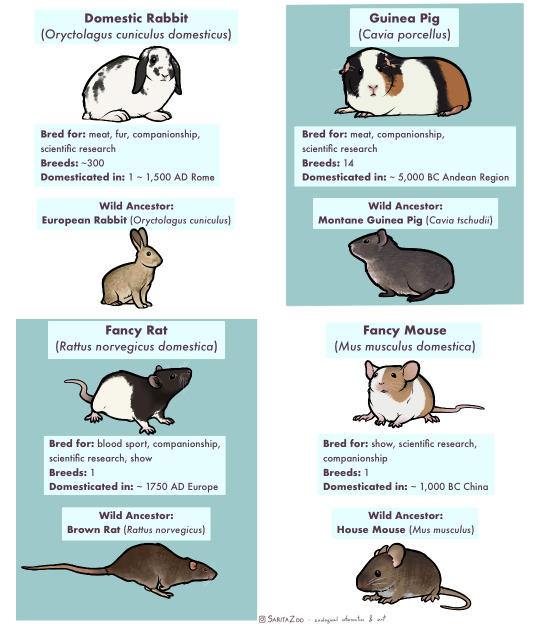
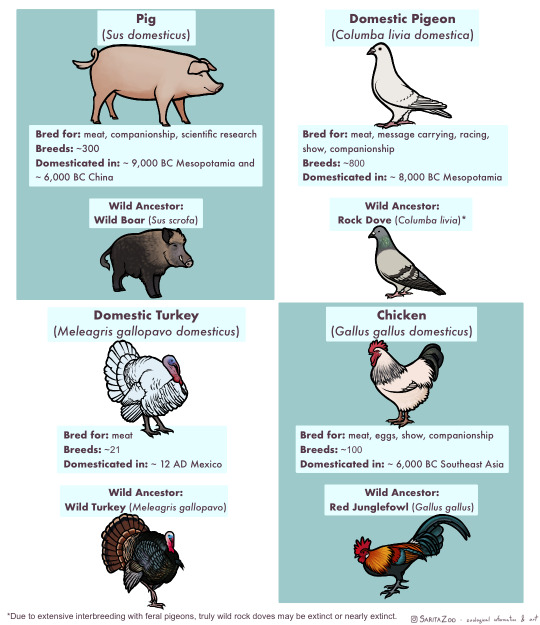
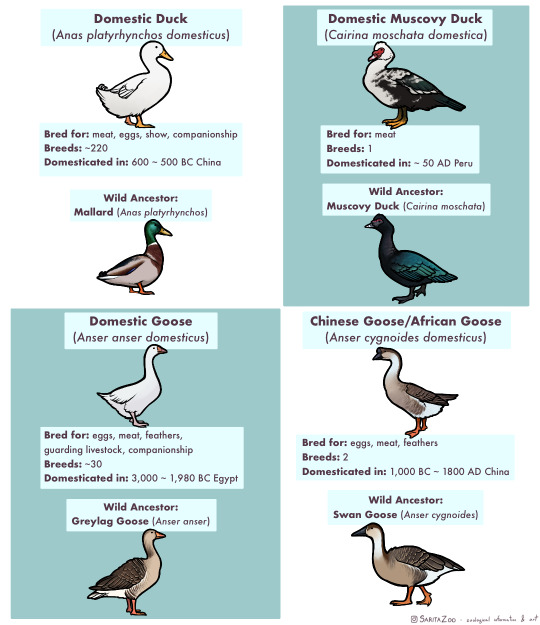
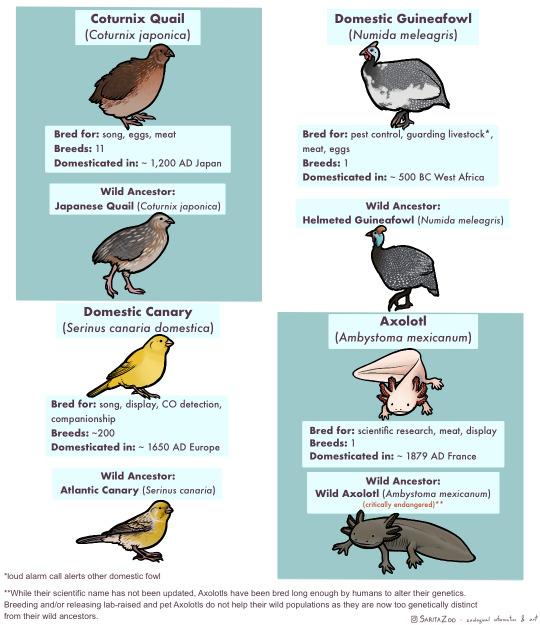
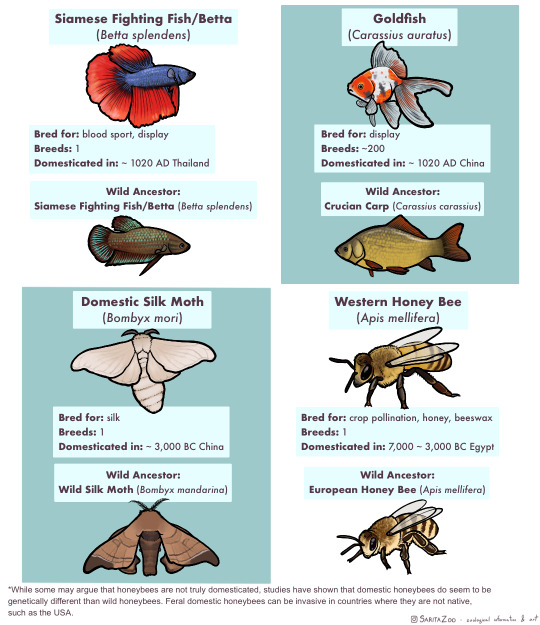

Phew. This one took, uh… a bit longer than expected due to other projects both irl and art-wise, but it’s finally here. The long-awaited domestic animal infographic! Unfortunately, I didn’t have enough space to cover every single domestic animal (I’m so sorry, reindeer and koi, my beloveds) but I tried to include as many of the “major ones” as possible.
I made this chart in response to a lot of the misunderstandings I hear concerning domestic animals, so I hope it’s helpful!
Further information I didn’t have any room to add or expand on:
🐈 “Breed” and “species” are not synonyms! Breeds are specific to domesticated animals. A Bengal Tiger is a species of tiger. A Siamese is a breed of domestic cat.
🐀 Different colors are also not what makes a breed. A breed is determined by having genetics that are unique to that breed. So a “bluenose pitbull” is not a different breed from a “rednose pitbull”, but an American Pitbull Terrier is a different breed from an American Bully! Animals that have been domesticated for longer tend to have more seperate breeds as these differing genetics have had time to develop.
🐕 It takes hundreds of generations for an animal to become domesticated. While the “domesticated fox experiment” had interesting results, there were not enough generations involved for the foxes to become truly domesticated and their differences from wild foxes were more due to epigenetics (heritable traits that do not change the DNA sequence but rather activate or deactivate parts of it; owed to the specific circumstances of its parents’ behavior and environment.)
🐎 Wild animals that are raised in human care are not domesticated, but they can be considered “tamed.” This means that they still have all their wild instincts, but are less inclined to attack or be frightened of humans. A wild animal that lives in the wild but near human settlements and is less afraid of humans is considered “habituated.” Tamed and habituated animals are not any less dangerous than wild animals, and should still be treated with the same respect. Foxes, otters, raccoons, servals, caracals, bush babies, opossums, owls, monkeys, alligators, and other wild animals can be tamed or habituated, but they have not undergone hundreds of generations of domestication, so they are not domesticated animals.
🐄 Also, as seen above, these animals have all been domesticated for a reason, be it food, transport, pest control, or otherwise, at a time when less practical options existed. There is no benefit to domesticating other species in the modern day, so if you’ve got a hankering for keeping a wild animal as a pet, instead try to find the domestic equivalent of that wild animal! There are several dog breeds that look and behave like wolves or foxes, pigeons and chickens can make great pet birds and have hundreds of colorful fancy breeds, rats can be just as intelligent and social as a small monkey (and less expensive and dangerous to boot,) and ferrets are pretty darn close to minks and otters! There’s no need to keep a wolf in a house when our ancestors have already spent 20,000+ years to make them house-compatible.
🐖 This was stated in the infographic, but I feel like I must again reiterate that domestic animals do not belong in the wild, and often become invasive when feral. Their genetics have been specifically altered in such a way that they depend on humans for optimal health. We are their habitat. This is why you only really see feral pigeons in cities, and feral cats around settlements. They are specifically adapted to live with humans, so they stay even when unwanted. However, this does not mean they should live in a way that doesn’t put their health and comfort as a top priority! If we are their world, it is our duty to make it as good as possible. Please research any pet you get before bringing them home!
35K notes
·
View notes
Text
Peninsula Eldara- Fauna
Aqui está a compilação completa e revisada da fauna da Península de Eldara, incluindo mamíferos, aves, répteis, anfíbios, fauna costeira e marinha, criaturas fantásticas e espécies extintas desde a Era do Gelo até hoje. Todas as informações foram extraídas e organizadas a partir do histórico do chat e dos documentos fornecidos.
🐾 Fauna Terrestre da Península de Eldara
🦊 1. Mamíferos Terrestres
Pequenos e Médios Mamíferos do Mediterrâneo
✔ Coelho-europeu (Oryctolagus cuniculus)
✔ Doninha-europeia (Mustela nivalis)
✔ Rato-do-campo (Apodemus sylvaticus)
��� Ouriço-cacheiro (Erinaceus europaeus)
Grandes Mamíferos da Floresta e Morros
✔ Lobo-ibérico (Canis lupus signatus)
✔ Javali (Sus scrofa)
✔ Lince-ibérico (Lynx pardinus)
✔ Veado-vermelho (Cervus elaphus barbarus)
✔ Cavalo-selvagem (Equus ferus ferus)
🏺 Espécies Extintas da Era do Gelo:
✔ Auroques (Bos primigenius) – Antigo bovino selvagem.
✔ Leopardo europeu (Panthera pardus spelaea) – Predador de grandes florestas.
✔ Rinoceronte-lanudo (Coelodonta antiquitatis) – Espécie já extinta.
✔ Leão-das-cavernas-europeu (Panthera spelaea) – Gigante felino pré-histórico.
🐉 Fantásticos:
✔ Felinos Élficos – Grandes felinos com habilidades de camuflagem mágica.
✔ Cervos Espectrais – Criaturas feéricas, reverenciadas por druidas.
🦅 2. Aves Terrestres e Costeiras
✔ Águia-real (Aquila chrysaetos)
✔ Falcão-peregrino (Falco peregrinus)
✔ Coruja-das-torres (Tyto alba)
✔ Gralha-preta (Corvus corone)
✔ Pardal-comum (Passer domesticus)
✔ Pelicano-branco (Pelecanus onocrotalus)
✔ Garça-real (Ardea cinerea)
✔ Flamingo-comum (Phoenicopterus roseus)
🏺 Extintas da Era do Gelo:
✔ Condor-europeu (Aegypius monachus, raríssimo hoje)
✔ Corvo-gigante do Pleistoceno (Corvus antecorax)
🐉 Fantásticos:
✔ Grifos – Habitantes das falésias e montanhas.
✔ Rocs Menores – Predadores alados gigantes.
✔ Corvos Inteligentes – Associados a entidades feéricas.
🦎 3. Répteis e Anfíbios
✔ Lagarto-ocelado (Timon lepidus)
✔ Cobra-lisa-do-mato (Coronella girondica)
✔ Sapo-comum (Bufo bufo)
✔ Salamandra-de-fogo (Salamandra salamandra)
🏺 Extintos ou raros:
✔ Tartaruga-gigante do Mediterrâneo (Centrochelys sulcata)
🐉 Fantásticos:
✔ Wyverns Menores – Encontrados em falésias rochosas e morros.
🌊 Fauna Aquática da Península de Eldara
🐬 4. Mamíferos Marinhos e Costeiros
✔ Golfinho-comum (Delphinus delphis)
✔ Foca-monge-mediterrânea (Monachus monachus, criticamente ameaçada)
✔ Baleia-de-bryde (Balaenoptera edeni, rara)
🐉 Fantásticos:
✔ Tritões e Nereidas – Guardiões místicos das águas.
✔ Dragões-marinhos – Criaturas místicas de recifes submersos.
🐟 5. Peixes de Águas Costeiras e Recifes
✔ Sardinha-europeia (Sardina pilchardus)
✔ Cavala (Scomber scombrus)
✔ Dourada (Sparus aurata)
✔ Robalo (Dicentrarchus labrax)
✔ Moreia-mediterrânea (Muraena helena)
✔ Polvo-comum (Octopus vulgaris)
🏺 Extintos da Era do Gelo:
✔ Atum-do-Mediterrâneo (Subespécie Gigante) (Thunnus thynnus macrocephalus)
🐉 Fantásticos:
✔ Bloodfish – Peixe carnívoro de águas avermelhadas.
✔ Swordfish – Peixe predador com habilidades mágicas de corte.
🦐 6. Crustáceos e Invertebrados
✔ Caranguejo-de-rio (Potamon fluviatile)
✔ Lagostim-europeu (Astacus astacus)
✔ Medusa-luminosa (Pelagia noctiluca)
🐉 Fantásticos:
✔ Brineshade Moss – Musgo salino para rituais mágicos.
✔ Deep-Sea Faerie – Seres feéricos que brilham na água.
🔥 Monstros e Criaturas Fantásticas da Península de Eldara
✔ Ankhegs – Escavam túneis sob florestas.
✔ Dryads – Protetoras das florestas encantadas.
✔ Treants menores – Guardiões das árvores mais antigas.
✔ Mímicos – Disfarçados como rochas e objetos perdidos.
✔ Harpias – Habitantes de penhascos costeiros.
✔ Wyverns menores – Predadores florestais e de montanhas.
✔ Chuuls – Criaturas crustáceas de águas profundas.
✔ Koalinths – Guerreiros goblinoides aquáticos.
✔ Merrows – Criaturas brutais das águas costeiras.
✔ Sea Hags – Bruxas do mar que habitam cavernas submersas.
📜 Resumo Final
✔ Mamíferos, aves, répteis, anfíbios e peixes organizados por habitat.
✔ Espécies extintas e fósseis vivos foram incorporados.
✔ Criaturas mágicas e lendárias complementam a biodiversidade da região.
Se precisar de mais ajustes ou quiser aprofundar alguma categoria específica, posso expandir a lista! 🚀
Ótima pergunta! Agora vou revisar e garantir que todos os animais de água doce da Península de Eldara estejam inclusos na lista. Aqui está a versão revisada e completa, com peixes, anfíbios, répteis, aves e mamíferos de rios, lagos, estuários e pântanos.
🌊 Fauna de Água Doce da Península de Eldara
🐟 1. Peixes de Água Doce e Rios Costeiros
✔ Truta-marrom (Salmo trutta) – Comum em rios e riachos.
✔ Enguia-europeia (Anguilla anguilla) – Vive entre rios e o mar.
✔ Carpa-comum (Cyprinus carpio) – Peixe de fundo, encontrado em rios e lagos tranquilos.
✔ Barbo-do-Mediterrâneo (Barbus meridionalis) – Resistente, vive em águas correntes.
✔ Peixe-lobo (Esox lucius) – Predador voraz de rios e lagos.
✔ Bagre-europeu (Silurus glanis) – Peixe grande de hábitos noturnos.
✔ Tainha-de-água-doce (Mugil cephalus) – Sobrevive em águas salobras perto dos deltas.
✔ Peixe-sol (Lepomis gibbosus) – Colorido e comum em águas calmas.
🏺 Espécies extintas ou raras desde a Era do Gelo:
✔ Esturjão-europeu (Acipenser sturio) – Peixe migratório altamente valorizado.
✔ Peixe-espátula-europeu (Polyodon europaeus, extinto).
🐉 Fantásticos:
✔ Gibberfish – Peixe caótico que emite sons enlouquecedores.
✔ Seaflame Koi – Peixe encantado que brilha sob a lua.
✔ Goldenscale Pike – Variante mágica do peixe-lobo com escamas valiosas.
🦐 2. Crustáceos, Anfíbios e Invertebrados de Água Doce
✔ Lagostim-europeu (Astacus astacus) – Vive em águas limpas e oxigenadas.
✔ Camarão-dos-rios (Palaemonetes antennarius) – Pequeno camarão de águas doces.
✔ Caranguejo-de-rio (Potamon fluviatile) – Essencial para a cadeia alimentar.
✔ Rã-verde (Pelophylax lessonae) – Comum em pântanos e margens de rios.
✔ Salamandra-de-fogo (Salamandra salamandra) – Vive em florestas úmidas e margens de riachos.
🐉 Fantásticos:
✔ Slipper-Slicer Slug – Lesma predadora encontrada em manguezais e pântanos.
✔ Glowtoad – Sapo luminescente usado em feitiçaria.
✔ Mistweaver Salamander – Criatura anfíbia capaz de desaparecer em névoas.
🐊 3. Répteis de Águas Doces e Pântanos
✔ Cágado-mediterrânico (Mauremys leprosa) – Vive em pântanos e rios tranquilos.
✔ Cobra-d’água (Natrix maura) – Não venenosa, mas predadora de pequenos peixes e anfíbios.
✔ Lagarto-de-água (Lacerta bilineata) – Comum em áreas úmidas próximas a rios.
🐉 Fantásticos:
✔ Aqua Viper – Serpente mágica que hipnotiza suas presas.
✔ Dragon Turtle Juvenil – Pequena tartaruga-dragão.
🦆 4. Aves de Águas Doces e Pântanos
✔ Garça-real (Ardea cinerea) – Caça peixes e rãs em águas rasas.
✔ Cegonha-branca (Ciconia ciconia) – Nidifica em áreas úmidas e abertas.
✔ Pato-real (Anas platyrhynchos) – Onívoro, comum em lagos e rios calmos.
✔ Colhereiro-europeu (Platalea leucorodia) – Pássaro raro, visto em pântanos.
✔ Águia-pesqueira (Pandion haliaetus) – Grande predadora que caça peixes.
🐉 Fantásticos:
✔ Storm Heron – Garça mágica que manipula nevoeiros.
✔ Sky Drake – Pequeno dragão plumado que vive em estuários e rios.
🦦 5. Mamíferos Semi-Aquáticos
✔ Lontra-europeia (Lutra lutra) – Excelente caçadora de peixes e camarões.
✔ Rato-d’água (Arvicola amphibius) – Pequeno roedor de rios e pântanos.
✔ Marta-d’água (Mustela lutreola) – Espécie rara e ameaçada na região.
🐉 Fantásticos:
✔ Otterkin – Lontras inteligentes, conhecidas por auxiliar pescadores mágicos.
✔ Aquamorph Badger – Criatura adaptável que pode respirar debaixo d’água.
📜 Resumo Final: Água Doce na Península de Eldara
✔ Peixes comuns, extintos e fantásticos foram adicionados.
✔ Crustáceos, anfíbios e invertebrados foram listados detalhadamente.
✔ Répteis, aves aquáticas e mamíferos semi-aquáticos foram incluídos.
✔ Criaturas mágicas e mitológicas complementam a biodiversidade mística da região.
0 notes
Text
El Latín
El latín es una lengua muerta. No es ya la lengua de ninguna nación o pueblo, pero hace 2500 años todavía la hablaban millones de personas.
Fue un idioma que se hablaba en el centro de Italia y con la expandión de Roma llegó a ser la lengua de todo el imperio, desde Portugal hasta Jordania y desde Francia hasta Egipto.
Es una lengua desinencial, las palabras cambian según su función. Por ejemplo, rey es Rex, ama es amat y reina es regina... Pero no se dice Rex amat regina... sino Rex reginam amat ... aquí regina es un complemento directo, entonces debe terminar en am... pero eso es porque pertenece a la primera declinación... Si la palabra perteneciera a a la tercera declinación como CANIS (perro), su complemento directo es CANEM.
El 70 por ciento de las palabras del castellano viene del latín. Pero hay que acotar algo, ya para mediados del imperio había dos tipos de latín: el culto y el popular. Casi todo el latín que sobrevivió en el castellano viene del popular. Por ejemplo, la gente culta, hace 2500 años, para decir caballo decían equus, el pueblo decía caballus, y este fue el que sobrevivó. Aunque equus lo encontramos en palabras como ecuestre o equitación.
Los cultos para decir casa decían domus, el pueblo decía casa, porque ningún pobre vvía en una domus. Una domus era como una quinta, una mansión, las casas eran las chozas de los campesinos.
La palabra pagano que muchos de ustedes han escuchado viene de paganus que signficaba campesino. ¿Porqué entonces se les decían paganos a los que aun no creían en Cristo?
Es que el cristianismo se propagó muy rapido en las ciudades. Los campesinos eran muy reacios a abandonar a sus antiguos dioses. Ellos siempre habían estado cerca de la naturaleza y les costaba eso de ya no creer en faunos, sátiros, dioses del agua, de la tierra o de la primavera. Le costó mucho a los primeros lideres cristianos evangelizar a los campesinos... o sea, a los "paganus".
Durante siglos la iglesia católica usó el latín como idioma ofificial. Me parece que esto fue abolido en el Concilio Vaticano II (Hace unos 60 años).
En la imagen la entrada de una antigua domus en Pompeya. En el piso hay un mosaico con un perro y la inscripción en latín CAVE CANEM... Se traduce correctamente como "Cuidado con el perro", aunque gramaticalmente ese CANEM es un complemento directo, la traducción más correcta es : "CUIDADO, EL PERRO" y nos habla más o menos de como ellos hablaban, por ejemplo, no decían: Los soldados tomaron la ciudad, sino algo así como "Soldados, ciudad tomaron".
Para finalizar. hay una palabra latina o una forma de decir algo que siempre me ha gustado, porque es un fósil del idioma, una palabra que se coló, que sobrevivió... Ustedes saben que la conjunción copulativa es y. Por ejemplo: Ciudad y Pueblo, pero aunque ellos también tenían esa y (La escribían ET), tenían también otra forma de escribirla. La escribían: QUE, y al final de la palabra, Por ejemplo. URBE POPULUSQUE (La ciudad y el pueblo).
Ese QUE, como conjunción "y", todavía a veces lo usamos... Cuando dices:
César está escribe que escribe... Es porque quieres decir: César está escribe y escribe. O También Cuentame que te cuento: Cuentame y te cuento.
Y a propósito de CAVE CANEM... a los antiguos romanos les gustaba mucho esas frases que tenían cierta cacofonía... Las construían a propósito y si algunas se daban de forma natural como CAVE CANEM mucho más les gustaba. Hay una que seguro han escuchado: URBE ET ORBI... (A la ciudad y al mundo).
Si llegaste hasta aquí, gracias por leer.
Y un ejercicio final... Uno de los emblemas de Roma eran las siglas: SPQR...
¿Qué significa?

0 notes
Text
Small correction: the Przewalski's horse, also called a tahki, is probably not the horse depicted in that cave art.
This got long, so I'm putting the rest under the cut, oops!
This photo is from a horse depicted as the Lascaux cave art site, and probably portrays some other subspecies of Equus ferus*, possibly an archaic version of Equus ferus caballus** or Equus ferus ferus. For reference, the Przewalski's horse is Equus ferus przewalskii, the domesticated horse is Equus ferus caballus, and the tarpan (extinct now :( ) is Equus ferus ferus.
*Latin titles should be italicized but I'm on tumblr mobile and that'll make the whole thing italicized so I'm not doing that
**Whether or not it's Equus ferus (third name) or just eg, Equus caballus, Equus przewalskii, etc. is up for debate. You may see some people just write the two names. Both styles are correct. (Dogs are like this too, funnily enough. Canis familiaris is often written as Canis lupus familiaris, to highlight the fact that dogs aren't a different species and are actually a subspecies of the gray wolf. )
BUT the Przewalski's horse LOOKS very, very similar to the older Equus ferus found in cave art! They were both rather stocky compared to domesticated horses, have a short mane, and were dun with countershading. Not all of these horses looked like that, though:

It's hard to find an illustration actually affiliated with any scientists or reputable sources, but I believe this is a very accurate one.
I originally had photos of the cave paintings with their locations and photographers, but tumblr mobile sucks ass and should die, so I'm just gonna put some pics here without that info.

Notice the large heads, short manes, and dark extremities

Spots! Yay! Also dark heads?

Harder to see with this pic, but the figure on the left is a brown horse with spots on its body, with a darker underbelly and legs. This could depict a brown horse with darker spots, or could depict a brown horse with dappled sunlight, we don't know. Ignore the aurochs on the left (or don't and give her a little smooch, just watch out for the horns!)
Watching Przewalski's horses run free on the Kazakhstan steppe for the first time in 200 years

73K notes
·
View notes
Note
1, 2, 8, and 26 with Nacht for the ask game?
Heya there, Anon~! Ah yes, obligatory Nacht questions for me, the resident Faust simp. Thank you for the questions. Hopefully the answers satisfy.
..........
1) My first impression of them
First... (plugs Nacht's ears) My man doesn't need to hear this. But...
I wasn't always a raging simp for Nacht. 😭 I know it's awful! I was a fool and needed time to fall for him!
The "holier than thou" attitude he pulled with the Bulls was less than compelling to me. I didn't hate him. I just wasn't totally interested. I did like his magic though. I'm a sucker for light/darkness dynamics and Shadow Magic fit in. Also I made jokes about him being a misanthrope. So that was fun.
2) When I think I truly started to like them (or dislike them, if you've sent me a character I don't like)
Chapter 286 and 287.
Those chapters sealed my fate for loving Nacht with no end!
The truth behind his hatred for the Bulls is him projecting! His struggle to show care towards his sweet brother! The complicated relationship he has with forgiveness and redemption! THE SEXY DELINQUENT NACHT LOOK! AAAAAAAHHHHHHHHH!
Older mutuals of mine can attest to the WHIPLASH I had with my attitude towards Nacht. They had their fun poking teasing me for how quickly I fell for Nacht and encouraging it. I love them for that.
8) Your favorite outfit of them
Hngh, hmmmmm! GGGGGHHHHHHHH! AAAAHHHHHH! HE HAS SO MANY GOOD LOOKS DARN IT!
The og look grew on me. And then there's the delinquent outfit. And hngh he also served in the Spade invasion uniform! AND THE DEVIL FORMS THE DEVIL FORMS MAKE ME FERAL (well, Equus and Canis x Equus not really cause they're so heavy).
All of them. I'm a weak simp and cannot choose one definitive favorite.
26) When do you think they were being "themselves" the most?
Ah, hmmm...
Probably when he was casting Kids' Playground with Yami. Nacht was beside his best friend once again and raising hell with him as they used to do. Nacht was letting loose after years of suppressing his more reckless side. But Nacht also voiced that he hated what he was doing, in the sense that he'd always been running from his past and now alongside Yami, he was reverting to his younger, no-good self.
It's the internal conflict Nacht has that makes the Kids' Playground moment feel like when he is being the most like himself. He was simultaneously a hell-raising delinquent and a righteous Magic Knight when he cast the spell.
6 notes
·
View notes
Text
FE Miniboss Battle Opening Round - Match 6

info and propaganda under the cut
THE DEADLORDS
Class: Baron/General (Mus) ; Hero/Bow Knight (Bovis) ; Warrior (Tigris) ; High Priest/War Cleric (Lepus) ; War Mage/Dark Knight (Anguilla) ; Bishop/Paladin (Equus) ; Sage (Ovis) ; Swordmaster (Simia) ; Dark Bishop/Sorcerer (Gallus) ; Priestess/Sage/Valkyrie (Canis) ; Rogue/Assassin (Porcus)
Appear in: Genealogy of the Holy War - Endgame ; Thracia 776 - Endgame ; Awakening - Chapter 22
Choice quote: "WE ARE THE DEADLORDS. WE DO NOT SUCCUMB TO MORTAL EMOTION." (Equus, Infinite Regalia DLC)
Propaganda:
no propaganda submitted.
KUMAGERA
Class: Oni Chieftain
Appears in: Fates - Chapter 14 (Conquest)
Choice quote: "We're not leaving until King Garon has met his maker. Stay out of our way!"
Propaganda:
no propaganda submitted.
9 notes
·
View notes